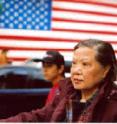Major study of Chinese-Americans debunks 'model minority' myth
Chinese Americans, one of the most highly educated groups in the nation, are confronted by a "glass ceiling," unable to realize full occupational stature and success to match their efforts, concludes a new study from the University of Maryland. The returns on Chinese Americans' investment in education and "sweat equity" are "generally lower than those in the general and non-Hispanic White population," says the report, "A Chinese American Portrait." It adds that, on average, Chinese American professionals in the legal and medical fields earn as much as 44 percent less than their White counterparts.
Based on extensive U.S. Census data and independent interviews, the study offers the most comprehensive and current portrait of the highly diverse Chinese American population. The research was conducted by the University of Maryland's Asian American Studies Program with support from OCA, a national community-based organization of Asian Pacific Americans. The data in the report go through 2006, the latest available.
"Contrary to popular beliefs, Chinese Americans often face extra barriers to economic success, despite their educational achievements," says principal investigator Larry H. Shinagawa, a demographer and Americans Studies professor who directs the University of Maryland Asian American Studies Program. (http://www.aast.umd.edu/director.html)
"Time and hard work simply haven't been enough for Chinese Americans to fully enter into mainstream social and professional circles," Shinagawa adds. "I suspect there are many reasons such as language barriers or simply the difficulties that go along with being identified as an 'outsider.' In the long run, increasing mentoring efforts and leadership opportunities can enhance the Chinese American community. You need a pipeline, a network to help young professionals rise to their potential, and increase Chinese American participation in top positions. Success begets success."
AN EXTREMELY DIVERSE CHINESE AMERICAN COMMUNITY
Yet this is only half the story. As Shinagawa points out, the Chinese American community is characterized by extreme diversity. It is split nearly 50-50 between poorly educated recent immigrants from China and a more settled, acculturated, educated and prosperous group of older immigrants and second generation Americans. These earlier arrivals came mainly from Taiwan and Hong Kong.
"It makes for a rather bi-polar picture of wealth and poverty, high and low education levels, white and blue collars," Shinagawa says. "It's a pattern you expect to see after a wave of immigration. But in this case, the long-term settled population has yet to achieve full equal treatment."
AMONG THE STUDIES FINDINGS:
- Fastest Growing Immigrant Group: Chinese Americans represent the fastest growing immigrant group in the nation (up 30 percent between 2000 and 2006, the most recent figures);
- Largest Asian Ethnic Group: Chinese Americans represent the largest ethnic group among Asian Americans (about 25 percent)
- Higher Education Clustering: Chinese Americans cluster in a small number of colleges and universities (only three percent of all higher education institutions);
- High Levels of Higher Education: Twice as many Chinese American adults have college degrees than the general population;
- Lacking High School Education: Conversely, recently arrived Chinese Americans represent the largest number of U.S. adults without the equivalent of a high school education;
- Occupations: Chinese Americans are more heavily represented in professional and managerial occupations than the general population (53 percent vs. 34 percent);
- Industries: Chinese Americans cluster in industries associated with healthcare, food services, manufacturing and professional/scientific fields;
- Pay Equity: Chinese American men earn less in salaries than majority Whites for the same level of education;
- Geographic Clustering: 60 percent of all Chinese Americans live in a handful of cities beginning with New York City, San Francisco, Los Angeles, Chicago, Philadelphia, as well as the Washington, D.C. metropolitan area, the Boston metro area and the Dallas metro area.
- Suburban Migration: In the past 20 years, Chinese Americans have settled increasingly away from traditional ethnic enclaves characterized as Chinatowns. Many of the more affluent Chinese Americans now reside in suburban communities commonly known as "ethnoburbs" or mixed "Asiatowns;"
- Citizenship: Three out of four Chinese Americans are U.S. citizens and exhibit very high rates of naturalization. However, this is less true among the recent immigrants who have been slower to seek citizenship;
- Multiethnic/Multiracial: One in ten Chinese Americans are multiethnic and/or multiracial;
- Divorce: Once they marry, Chinese Americans tend to stay married – with a divorce rate less than half that of the general population (4.4 percent vs. 10 percent)
RECOMMENDATION
"This study marks the progress of Chinese Americans entering the mainstream fabric of American life as well as the challenges that remain," Shinagawa says. "It surely demonstrates the need to stop treating Chinese Americans as a monolithic group. Different segments of the population have very different needs. 'One size fits all' simply won't work. We hope recognition of this diversity will serve as a guide for policy makers so that their decisions will improve the lives of all Chinese Americans and Asian Americans."
Source: University of Maryland
Other sources
- Major Study Of Chinese-Americans Debunks 'Model Minority' Mythfrom Science DailyWed, 12 Nov 2008, 16:21:15 UTC
- Major study of Chinese-Americans debunks 'model minority' mythfrom PhysorgWed, 12 Nov 2008, 15:49:13 UTC
